Thai Beverage: Comprehensive Business Strategy Analysis and Evaluation
VerifiedAdded on 2022/10/15
|12
|3596
|235
Report
AI Summary
This report provides a comprehensive analysis of Thai Beverage's business strategy. It begins with an introduction and overview of the company's strategies, including growth, diversity, branding, and reach. The report then evaluates the environmental impacts using a PESTLE analysis, examining political, economic, social, technological, legal, and environmental factors. The internal environment is assessed using Porter's Five Forces. Furthermore, the report explores Thai Beverage's strategic capabilities and sources of competitive advantage, applying Porter's Value Chain and VRIO framework. Key issues and challenges confronting the company are identified, followed by recommendations for future success. The report concludes with a discussion of the company's position in the competitive beverage market and its potential for continued growth.
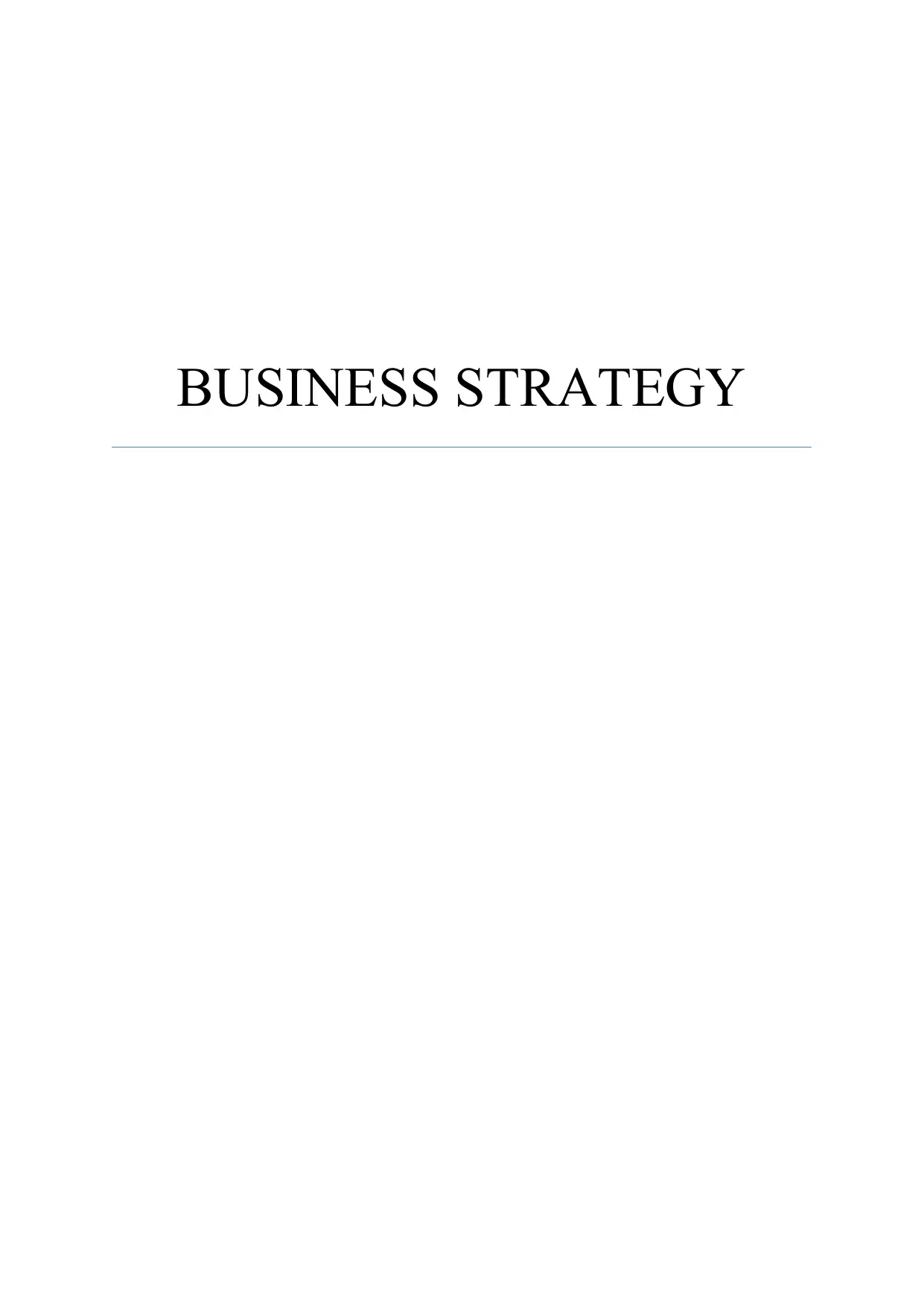
BUSINESS STRATEGY
Paraphrase This Document
Need a fresh take? Get an instant paraphrase of this document with our AI Paraphraser
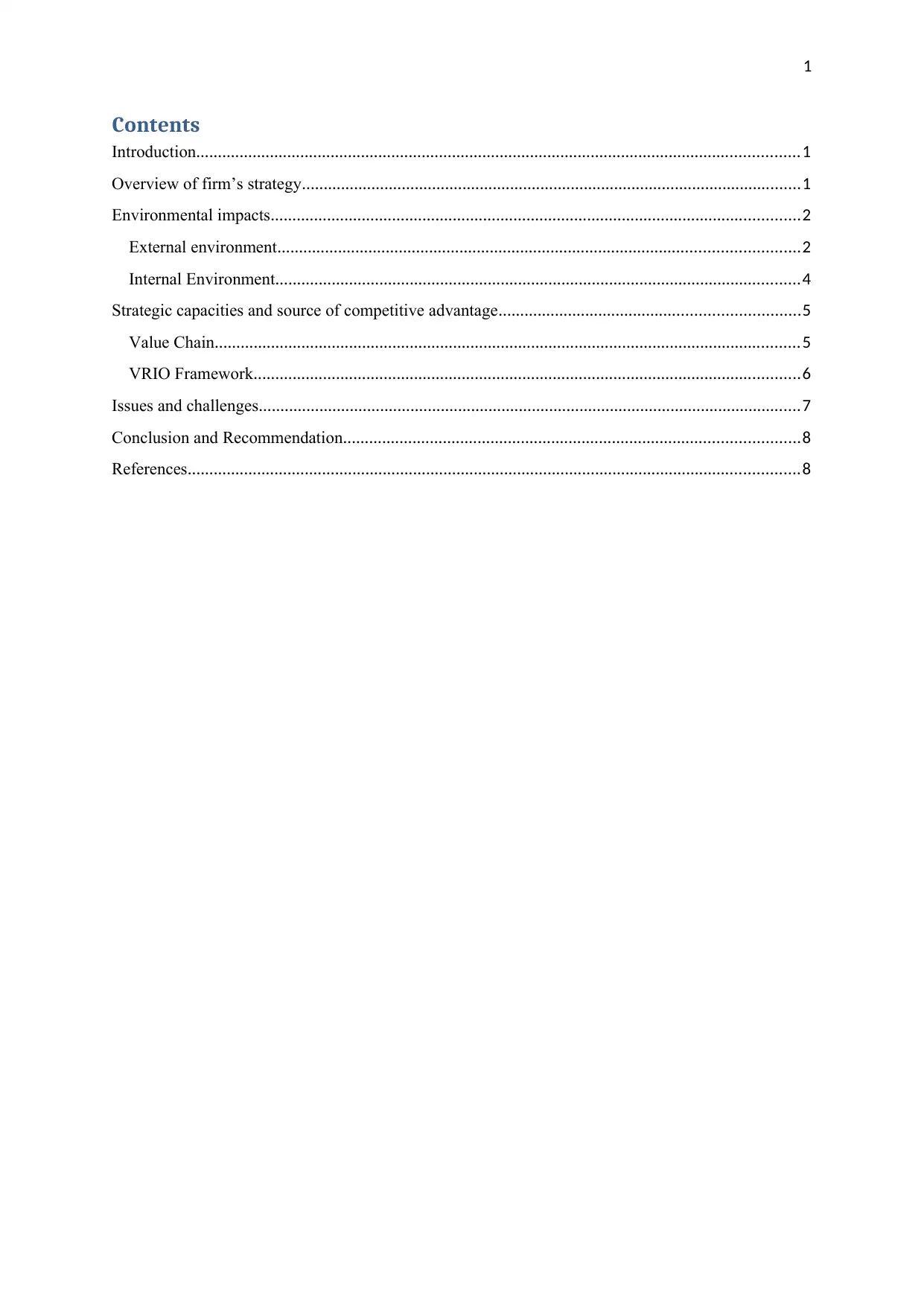
1
Contents
Introduction...........................................................................................................................................1
Overview of firm’s strategy...................................................................................................................1
Environmental impacts..........................................................................................................................2
External environment........................................................................................................................2
Internal Environment.........................................................................................................................4
Strategic capacities and source of competitive advantage.....................................................................5
Value Chain.......................................................................................................................................5
VRIO Framework..............................................................................................................................6
Issues and challenges.............................................................................................................................7
Conclusion and Recommendation.........................................................................................................8
References.............................................................................................................................................8
Contents
Introduction...........................................................................................................................................1
Overview of firm’s strategy...................................................................................................................1
Environmental impacts..........................................................................................................................2
External environment........................................................................................................................2
Internal Environment.........................................................................................................................4
Strategic capacities and source of competitive advantage.....................................................................5
Value Chain.......................................................................................................................................5
VRIO Framework..............................................................................................................................6
Issues and challenges.............................................................................................................................7
Conclusion and Recommendation.........................................................................................................8
References.............................................................................................................................................8
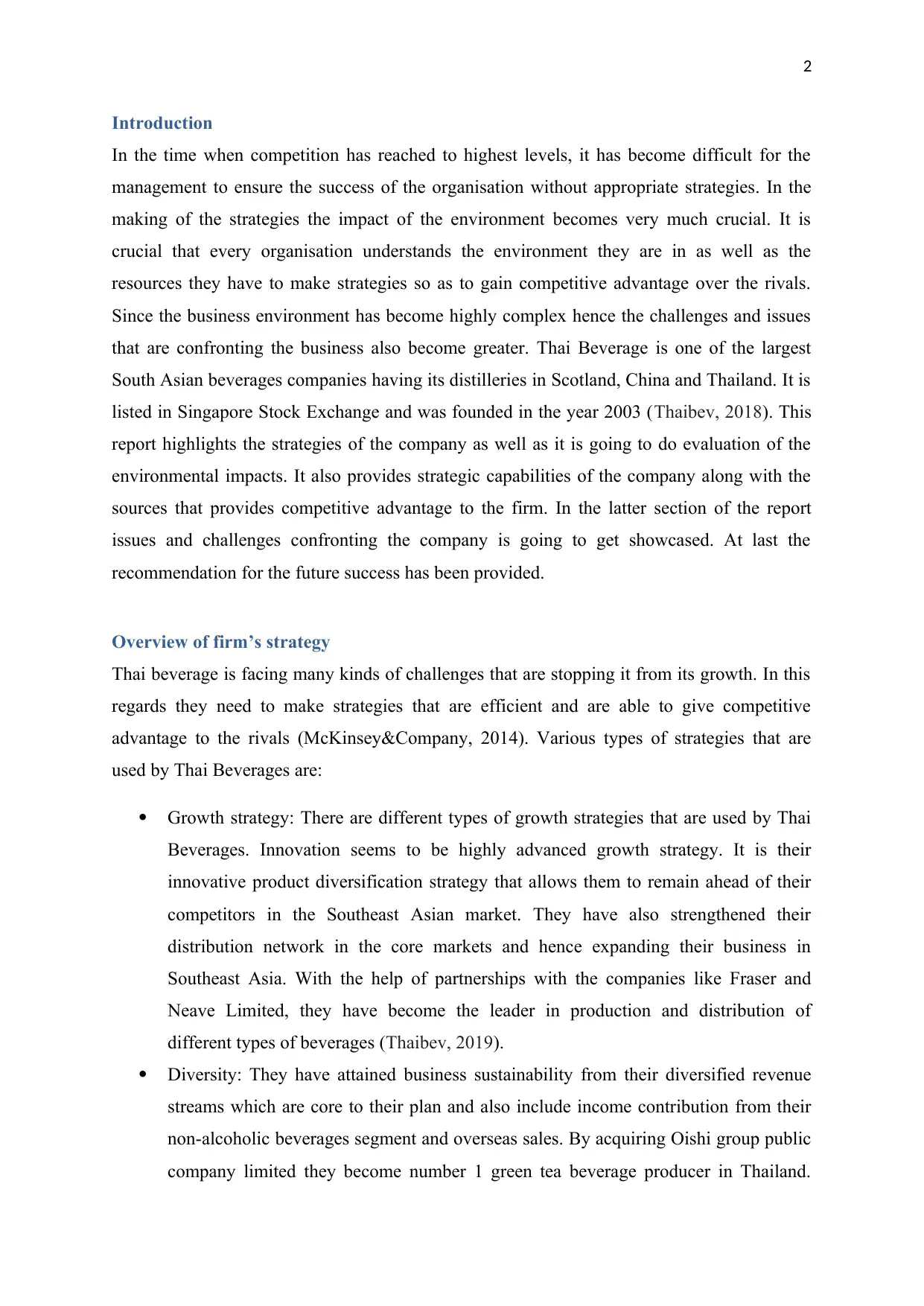
2
Introduction
In the time when competition has reached to highest levels, it has become difficult for the
management to ensure the success of the organisation without appropriate strategies. In the
making of the strategies the impact of the environment becomes very much crucial. It is
crucial that every organisation understands the environment they are in as well as the
resources they have to make strategies so as to gain competitive advantage over the rivals.
Since the business environment has become highly complex hence the challenges and issues
that are confronting the business also become greater. Thai Beverage is one of the largest
South Asian beverages companies having its distilleries in Scotland, China and Thailand. It is
listed in Singapore Stock Exchange and was founded in the year 2003 (Thaibev, 2018). This
report highlights the strategies of the company as well as it is going to do evaluation of the
environmental impacts. It also provides strategic capabilities of the company along with the
sources that provides competitive advantage to the firm. In the latter section of the report
issues and challenges confronting the company is going to get showcased. At last the
recommendation for the future success has been provided.
Overview of firm’s strategy
Thai beverage is facing many kinds of challenges that are stopping it from its growth. In this
regards they need to make strategies that are efficient and are able to give competitive
advantage to the rivals (McKinsey&Company, 2014). Various types of strategies that are
used by Thai Beverages are:
Growth strategy: There are different types of growth strategies that are used by Thai
Beverages. Innovation seems to be highly advanced growth strategy. It is their
innovative product diversification strategy that allows them to remain ahead of their
competitors in the Southeast Asian market. They have also strengthened their
distribution network in the core markets and hence expanding their business in
Southeast Asia. With the help of partnerships with the companies like Fraser and
Neave Limited, they have become the leader in production and distribution of
different types of beverages (Thaibev, 2019).
Diversity: They have attained business sustainability from their diversified revenue
streams which are core to their plan and also include income contribution from their
non-alcoholic beverages segment and overseas sales. By acquiring Oishi group public
company limited they become number 1 green tea beverage producer in Thailand.
Introduction
In the time when competition has reached to highest levels, it has become difficult for the
management to ensure the success of the organisation without appropriate strategies. In the
making of the strategies the impact of the environment becomes very much crucial. It is
crucial that every organisation understands the environment they are in as well as the
resources they have to make strategies so as to gain competitive advantage over the rivals.
Since the business environment has become highly complex hence the challenges and issues
that are confronting the business also become greater. Thai Beverage is one of the largest
South Asian beverages companies having its distilleries in Scotland, China and Thailand. It is
listed in Singapore Stock Exchange and was founded in the year 2003 (Thaibev, 2018). This
report highlights the strategies of the company as well as it is going to do evaluation of the
environmental impacts. It also provides strategic capabilities of the company along with the
sources that provides competitive advantage to the firm. In the latter section of the report
issues and challenges confronting the company is going to get showcased. At last the
recommendation for the future success has been provided.
Overview of firm’s strategy
Thai beverage is facing many kinds of challenges that are stopping it from its growth. In this
regards they need to make strategies that are efficient and are able to give competitive
advantage to the rivals (McKinsey&Company, 2014). Various types of strategies that are
used by Thai Beverages are:
Growth strategy: There are different types of growth strategies that are used by Thai
Beverages. Innovation seems to be highly advanced growth strategy. It is their
innovative product diversification strategy that allows them to remain ahead of their
competitors in the Southeast Asian market. They have also strengthened their
distribution network in the core markets and hence expanding their business in
Southeast Asia. With the help of partnerships with the companies like Fraser and
Neave Limited, they have become the leader in production and distribution of
different types of beverages (Thaibev, 2019).
Diversity: They have attained business sustainability from their diversified revenue
streams which are core to their plan and also include income contribution from their
non-alcoholic beverages segment and overseas sales. By acquiring Oishi group public
company limited they become number 1 green tea beverage producer in Thailand.
⊘ This is a preview!⊘
Do you want full access?
Subscribe today to unlock all pages.

Trusted by 1+ million students worldwide
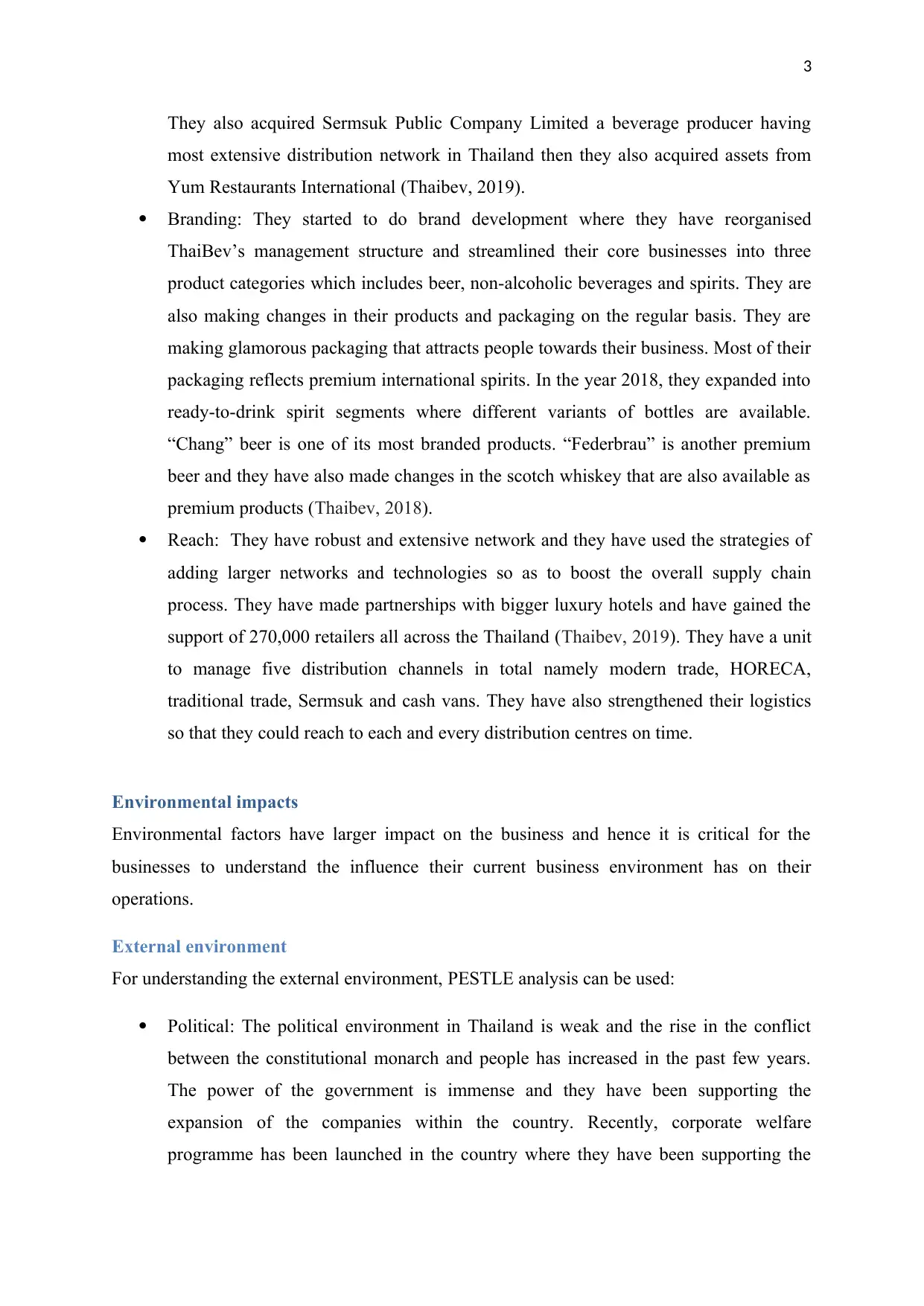
3
They also acquired Sermsuk Public Company Limited a beverage producer having
most extensive distribution network in Thailand then they also acquired assets from
Yum Restaurants International (Thaibev, 2019).
Branding: They started to do brand development where they have reorganised
ThaiBev’s management structure and streamlined their core businesses into three
product categories which includes beer, non-alcoholic beverages and spirits. They are
also making changes in their products and packaging on the regular basis. They are
making glamorous packaging that attracts people towards their business. Most of their
packaging reflects premium international spirits. In the year 2018, they expanded into
ready-to-drink spirit segments where different variants of bottles are available.
“Chang” beer is one of its most branded products. “Federbrau” is another premium
beer and they have also made changes in the scotch whiskey that are also available as
premium products (Thaibev, 2018).
Reach: They have robust and extensive network and they have used the strategies of
adding larger networks and technologies so as to boost the overall supply chain
process. They have made partnerships with bigger luxury hotels and have gained the
support of 270,000 retailers all across the Thailand (Thaibev, 2019). They have a unit
to manage five distribution channels in total namely modern trade, HORECA,
traditional trade, Sermsuk and cash vans. They have also strengthened their logistics
so that they could reach to each and every distribution centres on time.
Environmental impacts
Environmental factors have larger impact on the business and hence it is critical for the
businesses to understand the influence their current business environment has on their
operations.
External environment
For understanding the external environment, PESTLE analysis can be used:
Political: The political environment in Thailand is weak and the rise in the conflict
between the constitutional monarch and people has increased in the past few years.
The power of the government is immense and they have been supporting the
expansion of the companies within the country. Recently, corporate welfare
programme has been launched in the country where they have been supporting the
They also acquired Sermsuk Public Company Limited a beverage producer having
most extensive distribution network in Thailand then they also acquired assets from
Yum Restaurants International (Thaibev, 2019).
Branding: They started to do brand development where they have reorganised
ThaiBev’s management structure and streamlined their core businesses into three
product categories which includes beer, non-alcoholic beverages and spirits. They are
also making changes in their products and packaging on the regular basis. They are
making glamorous packaging that attracts people towards their business. Most of their
packaging reflects premium international spirits. In the year 2018, they expanded into
ready-to-drink spirit segments where different variants of bottles are available.
“Chang” beer is one of its most branded products. “Federbrau” is another premium
beer and they have also made changes in the scotch whiskey that are also available as
premium products (Thaibev, 2018).
Reach: They have robust and extensive network and they have used the strategies of
adding larger networks and technologies so as to boost the overall supply chain
process. They have made partnerships with bigger luxury hotels and have gained the
support of 270,000 retailers all across the Thailand (Thaibev, 2019). They have a unit
to manage five distribution channels in total namely modern trade, HORECA,
traditional trade, Sermsuk and cash vans. They have also strengthened their logistics
so that they could reach to each and every distribution centres on time.
Environmental impacts
Environmental factors have larger impact on the business and hence it is critical for the
businesses to understand the influence their current business environment has on their
operations.
External environment
For understanding the external environment, PESTLE analysis can be used:
Political: The political environment in Thailand is weak and the rise in the conflict
between the constitutional monarch and people has increased in the past few years.
The power of the government is immense and they have been supporting the
expansion of the companies within the country. Recently, corporate welfare
programme has been launched in the country where they have been supporting the
Paraphrase This Document
Need a fresh take? Get an instant paraphrase of this document with our AI Paraphraser
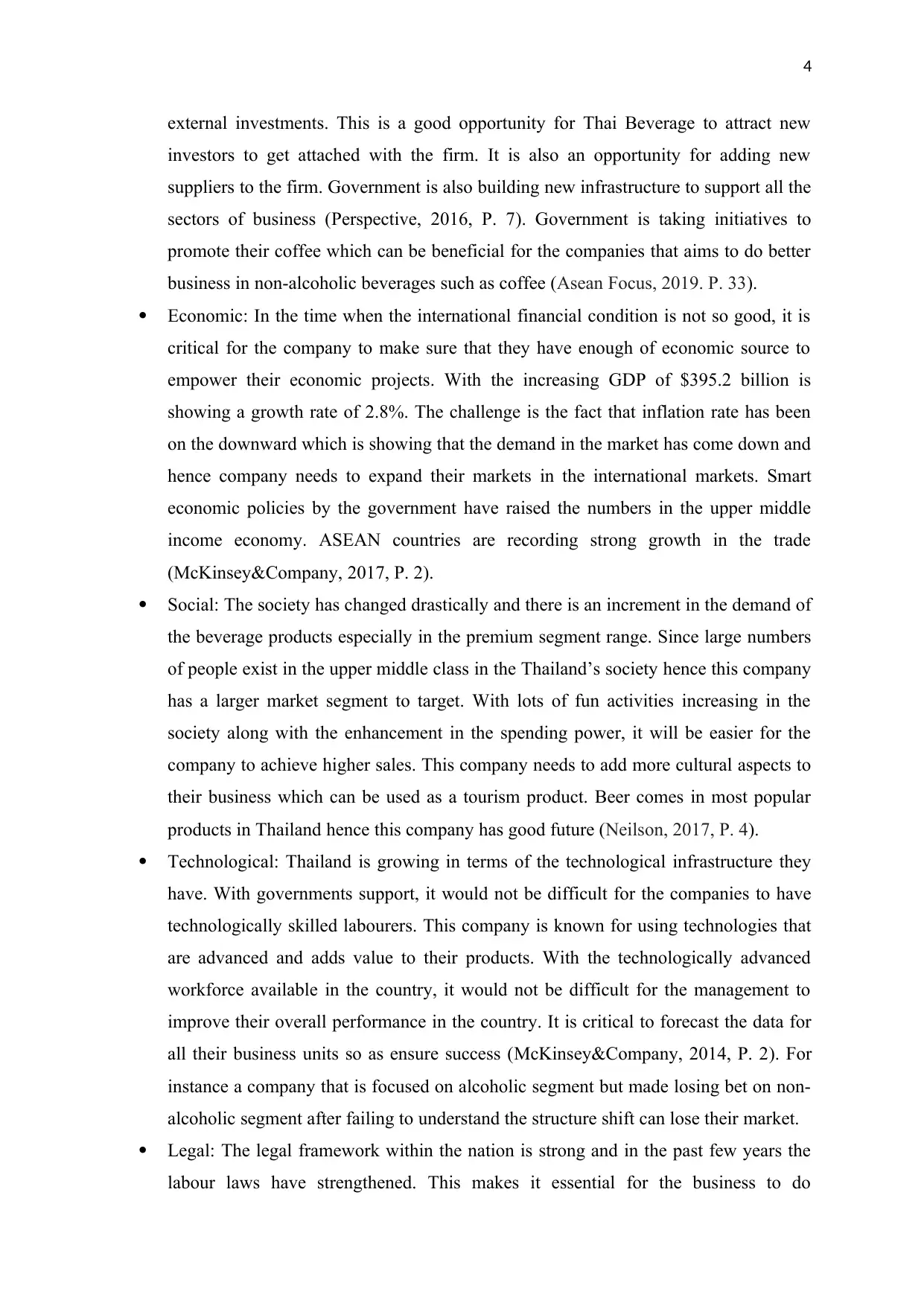
4
external investments. This is a good opportunity for Thai Beverage to attract new
investors to get attached with the firm. It is also an opportunity for adding new
suppliers to the firm. Government is also building new infrastructure to support all the
sectors of business (Perspective, 2016, P. 7). Government is taking initiatives to
promote their coffee which can be beneficial for the companies that aims to do better
business in non-alcoholic beverages such as coffee (Asean Focus, 2019. P. 33).
Economic: In the time when the international financial condition is not so good, it is
critical for the company to make sure that they have enough of economic source to
empower their economic projects. With the increasing GDP of $395.2 billion is
showing a growth rate of 2.8%. The challenge is the fact that inflation rate has been
on the downward which is showing that the demand in the market has come down and
hence company needs to expand their markets in the international markets. Smart
economic policies by the government have raised the numbers in the upper middle
income economy. ASEAN countries are recording strong growth in the trade
(McKinsey&Company, 2017, P. 2).
Social: The society has changed drastically and there is an increment in the demand of
the beverage products especially in the premium segment range. Since large numbers
of people exist in the upper middle class in the Thailand’s society hence this company
has a larger market segment to target. With lots of fun activities increasing in the
society along with the enhancement in the spending power, it will be easier for the
company to achieve higher sales. This company needs to add more cultural aspects to
their business which can be used as a tourism product. Beer comes in most popular
products in Thailand hence this company has good future (Neilson, 2017, P. 4).
Technological: Thailand is growing in terms of the technological infrastructure they
have. With governments support, it would not be difficult for the companies to have
technologically skilled labourers. This company is known for using technologies that
are advanced and adds value to their products. With the technologically advanced
workforce available in the country, it would not be difficult for the management to
improve their overall performance in the country. It is critical to forecast the data for
all their business units so as ensure success (McKinsey&Company, 2014, P. 2). For
instance a company that is focused on alcoholic segment but made losing bet on non-
alcoholic segment after failing to understand the structure shift can lose their market.
Legal: The legal framework within the nation is strong and in the past few years the
labour laws have strengthened. This makes it essential for the business to do
external investments. This is a good opportunity for Thai Beverage to attract new
investors to get attached with the firm. It is also an opportunity for adding new
suppliers to the firm. Government is also building new infrastructure to support all the
sectors of business (Perspective, 2016, P. 7). Government is taking initiatives to
promote their coffee which can be beneficial for the companies that aims to do better
business in non-alcoholic beverages such as coffee (Asean Focus, 2019. P. 33).
Economic: In the time when the international financial condition is not so good, it is
critical for the company to make sure that they have enough of economic source to
empower their economic projects. With the increasing GDP of $395.2 billion is
showing a growth rate of 2.8%. The challenge is the fact that inflation rate has been
on the downward which is showing that the demand in the market has come down and
hence company needs to expand their markets in the international markets. Smart
economic policies by the government have raised the numbers in the upper middle
income economy. ASEAN countries are recording strong growth in the trade
(McKinsey&Company, 2017, P. 2).
Social: The society has changed drastically and there is an increment in the demand of
the beverage products especially in the premium segment range. Since large numbers
of people exist in the upper middle class in the Thailand’s society hence this company
has a larger market segment to target. With lots of fun activities increasing in the
society along with the enhancement in the spending power, it will be easier for the
company to achieve higher sales. This company needs to add more cultural aspects to
their business which can be used as a tourism product. Beer comes in most popular
products in Thailand hence this company has good future (Neilson, 2017, P. 4).
Technological: Thailand is growing in terms of the technological infrastructure they
have. With governments support, it would not be difficult for the companies to have
technologically skilled labourers. This company is known for using technologies that
are advanced and adds value to their products. With the technologically advanced
workforce available in the country, it would not be difficult for the management to
improve their overall performance in the country. It is critical to forecast the data for
all their business units so as ensure success (McKinsey&Company, 2014, P. 2). For
instance a company that is focused on alcoholic segment but made losing bet on non-
alcoholic segment after failing to understand the structure shift can lose their market.
Legal: The legal framework within the nation is strong and in the past few years the
labour laws have strengthened. This makes it essential for the business to do
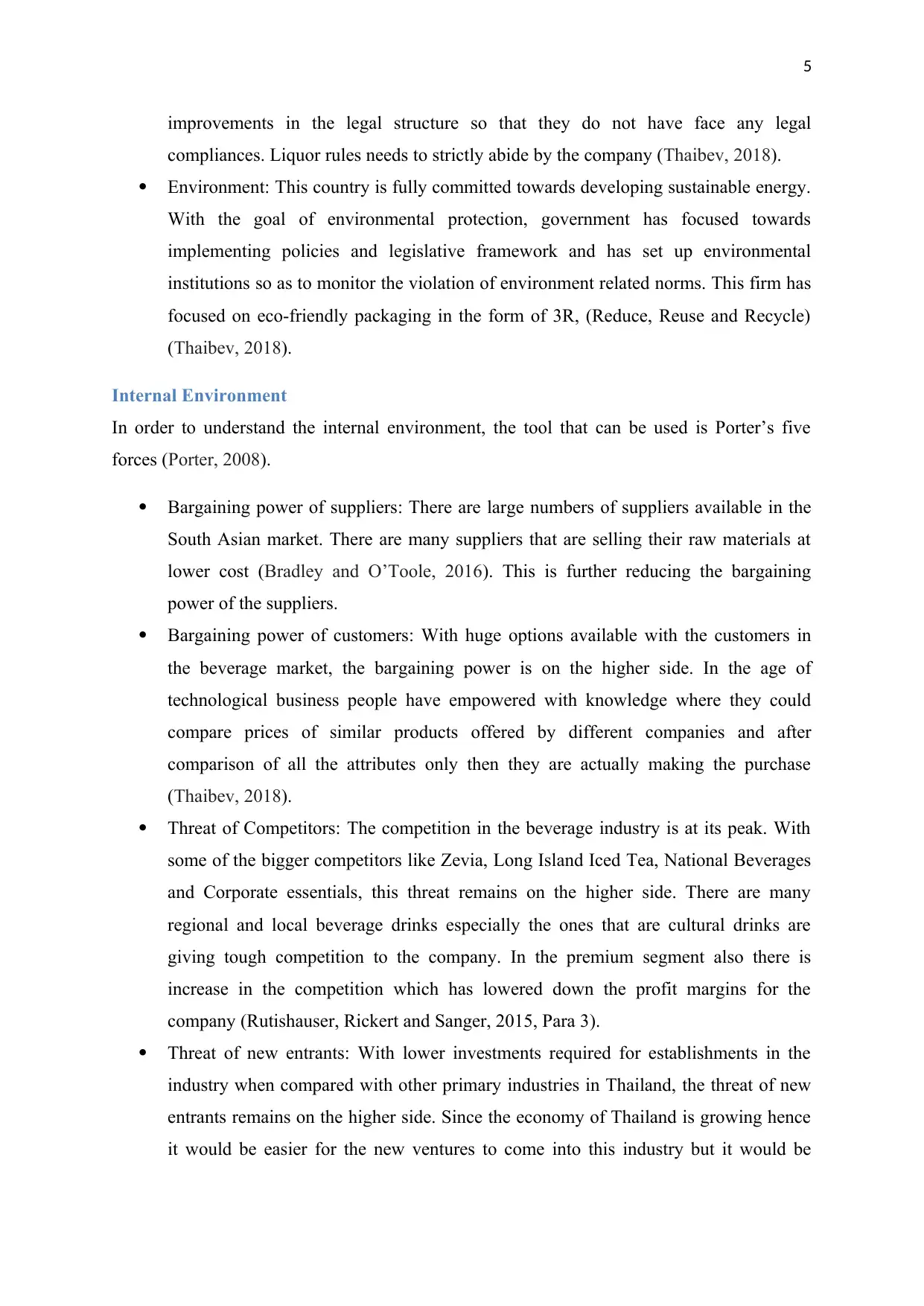
5
improvements in the legal structure so that they do not have face any legal
compliances. Liquor rules needs to strictly abide by the company (Thaibev, 2018).
Environment: This country is fully committed towards developing sustainable energy.
With the goal of environmental protection, government has focused towards
implementing policies and legislative framework and has set up environmental
institutions so as to monitor the violation of environment related norms. This firm has
focused on eco-friendly packaging in the form of 3R, (Reduce, Reuse and Recycle)
(Thaibev, 2018).
Internal Environment
In order to understand the internal environment, the tool that can be used is Porter’s five
forces (Porter, 2008).
Bargaining power of suppliers: There are large numbers of suppliers available in the
South Asian market. There are many suppliers that are selling their raw materials at
lower cost (Bradley and O’Toole, 2016). This is further reducing the bargaining
power of the suppliers.
Bargaining power of customers: With huge options available with the customers in
the beverage market, the bargaining power is on the higher side. In the age of
technological business people have empowered with knowledge where they could
compare prices of similar products offered by different companies and after
comparison of all the attributes only then they are actually making the purchase
(Thaibev, 2018).
Threat of Competitors: The competition in the beverage industry is at its peak. With
some of the bigger competitors like Zevia, Long Island Iced Tea, National Beverages
and Corporate essentials, this threat remains on the higher side. There are many
regional and local beverage drinks especially the ones that are cultural drinks are
giving tough competition to the company. In the premium segment also there is
increase in the competition which has lowered down the profit margins for the
company (Rutishauser, Rickert and Sanger, 2015, Para 3).
Threat of new entrants: With lower investments required for establishments in the
industry when compared with other primary industries in Thailand, the threat of new
entrants remains on the higher side. Since the economy of Thailand is growing hence
it would be easier for the new ventures to come into this industry but it would be
improvements in the legal structure so that they do not have face any legal
compliances. Liquor rules needs to strictly abide by the company (Thaibev, 2018).
Environment: This country is fully committed towards developing sustainable energy.
With the goal of environmental protection, government has focused towards
implementing policies and legislative framework and has set up environmental
institutions so as to monitor the violation of environment related norms. This firm has
focused on eco-friendly packaging in the form of 3R, (Reduce, Reuse and Recycle)
(Thaibev, 2018).
Internal Environment
In order to understand the internal environment, the tool that can be used is Porter’s five
forces (Porter, 2008).
Bargaining power of suppliers: There are large numbers of suppliers available in the
South Asian market. There are many suppliers that are selling their raw materials at
lower cost (Bradley and O’Toole, 2016). This is further reducing the bargaining
power of the suppliers.
Bargaining power of customers: With huge options available with the customers in
the beverage market, the bargaining power is on the higher side. In the age of
technological business people have empowered with knowledge where they could
compare prices of similar products offered by different companies and after
comparison of all the attributes only then they are actually making the purchase
(Thaibev, 2018).
Threat of Competitors: The competition in the beverage industry is at its peak. With
some of the bigger competitors like Zevia, Long Island Iced Tea, National Beverages
and Corporate essentials, this threat remains on the higher side. There are many
regional and local beverage drinks especially the ones that are cultural drinks are
giving tough competition to the company. In the premium segment also there is
increase in the competition which has lowered down the profit margins for the
company (Rutishauser, Rickert and Sanger, 2015, Para 3).
Threat of new entrants: With lower investments required for establishments in the
industry when compared with other primary industries in Thailand, the threat of new
entrants remains on the higher side. Since the economy of Thailand is growing hence
it would be easier for the new ventures to come into this industry but it would be
⊘ This is a preview!⊘
Do you want full access?
Subscribe today to unlock all pages.

Trusted by 1+ million students worldwide
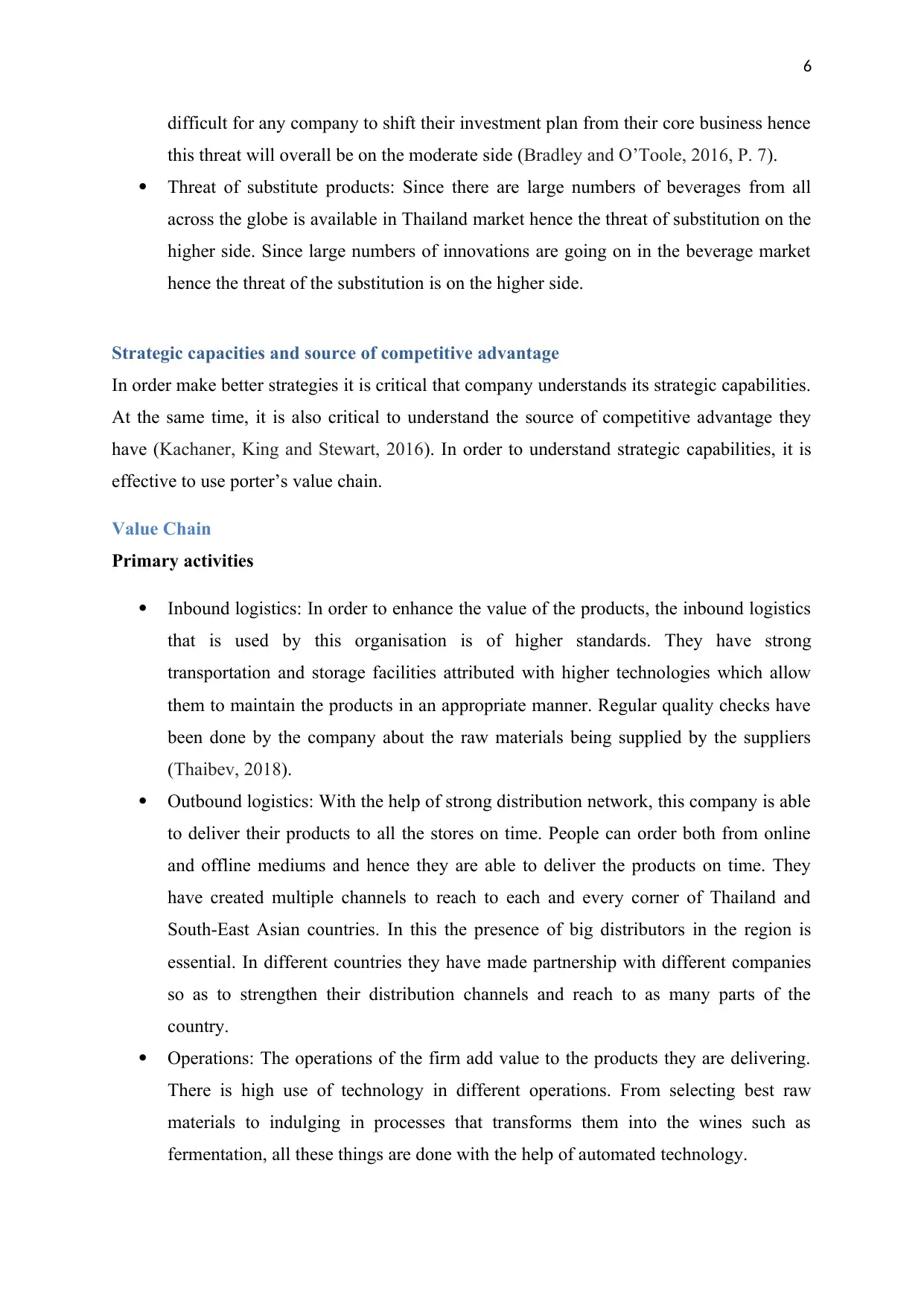
6
difficult for any company to shift their investment plan from their core business hence
this threat will overall be on the moderate side (Bradley and O’Toole, 2016, P. 7).
Threat of substitute products: Since there are large numbers of beverages from all
across the globe is available in Thailand market hence the threat of substitution on the
higher side. Since large numbers of innovations are going on in the beverage market
hence the threat of the substitution is on the higher side.
Strategic capacities and source of competitive advantage
In order make better strategies it is critical that company understands its strategic capabilities.
At the same time, it is also critical to understand the source of competitive advantage they
have (Kachaner, King and Stewart, 2016). In order to understand strategic capabilities, it is
effective to use porter’s value chain.
Value Chain
Primary activities
Inbound logistics: In order to enhance the value of the products, the inbound logistics
that is used by this organisation is of higher standards. They have strong
transportation and storage facilities attributed with higher technologies which allow
them to maintain the products in an appropriate manner. Regular quality checks have
been done by the company about the raw materials being supplied by the suppliers
(Thaibev, 2018).
Outbound logistics: With the help of strong distribution network, this company is able
to deliver their products to all the stores on time. People can order both from online
and offline mediums and hence they are able to deliver the products on time. They
have created multiple channels to reach to each and every corner of Thailand and
South-East Asian countries. In this the presence of big distributors in the region is
essential. In different countries they have made partnership with different companies
so as to strengthen their distribution channels and reach to as many parts of the
country.
Operations: The operations of the firm add value to the products they are delivering.
There is high use of technology in different operations. From selecting best raw
materials to indulging in processes that transforms them into the wines such as
fermentation, all these things are done with the help of automated technology.
difficult for any company to shift their investment plan from their core business hence
this threat will overall be on the moderate side (Bradley and O’Toole, 2016, P. 7).
Threat of substitute products: Since there are large numbers of beverages from all
across the globe is available in Thailand market hence the threat of substitution on the
higher side. Since large numbers of innovations are going on in the beverage market
hence the threat of the substitution is on the higher side.
Strategic capacities and source of competitive advantage
In order make better strategies it is critical that company understands its strategic capabilities.
At the same time, it is also critical to understand the source of competitive advantage they
have (Kachaner, King and Stewart, 2016). In order to understand strategic capabilities, it is
effective to use porter’s value chain.
Value Chain
Primary activities
Inbound logistics: In order to enhance the value of the products, the inbound logistics
that is used by this organisation is of higher standards. They have strong
transportation and storage facilities attributed with higher technologies which allow
them to maintain the products in an appropriate manner. Regular quality checks have
been done by the company about the raw materials being supplied by the suppliers
(Thaibev, 2018).
Outbound logistics: With the help of strong distribution network, this company is able
to deliver their products to all the stores on time. People can order both from online
and offline mediums and hence they are able to deliver the products on time. They
have created multiple channels to reach to each and every corner of Thailand and
South-East Asian countries. In this the presence of big distributors in the region is
essential. In different countries they have made partnership with different companies
so as to strengthen their distribution channels and reach to as many parts of the
country.
Operations: The operations of the firm add value to the products they are delivering.
There is high use of technology in different operations. From selecting best raw
materials to indulging in processes that transforms them into the wines such as
fermentation, all these things are done with the help of automated technology.
Paraphrase This Document
Need a fresh take? Get an instant paraphrase of this document with our AI Paraphraser
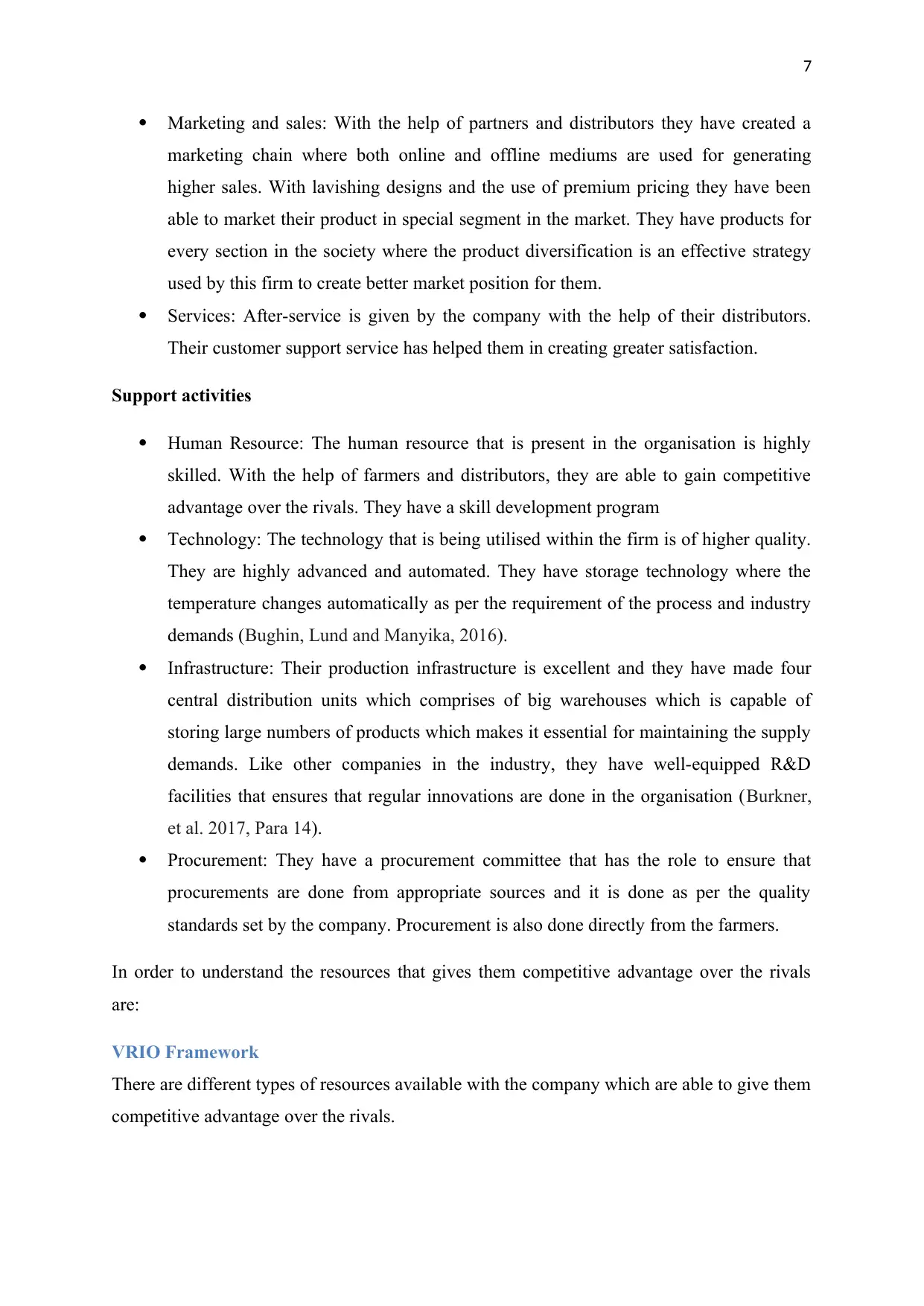
7
Marketing and sales: With the help of partners and distributors they have created a
marketing chain where both online and offline mediums are used for generating
higher sales. With lavishing designs and the use of premium pricing they have been
able to market their product in special segment in the market. They have products for
every section in the society where the product diversification is an effective strategy
used by this firm to create better market position for them.
Services: After-service is given by the company with the help of their distributors.
Their customer support service has helped them in creating greater satisfaction.
Support activities
Human Resource: The human resource that is present in the organisation is highly
skilled. With the help of farmers and distributors, they are able to gain competitive
advantage over the rivals. They have a skill development program
Technology: The technology that is being utilised within the firm is of higher quality.
They are highly advanced and automated. They have storage technology where the
temperature changes automatically as per the requirement of the process and industry
demands (Bughin, Lund and Manyika, 2016).
Infrastructure: Their production infrastructure is excellent and they have made four
central distribution units which comprises of big warehouses which is capable of
storing large numbers of products which makes it essential for maintaining the supply
demands. Like other companies in the industry, they have well-equipped R&D
facilities that ensures that regular innovations are done in the organisation (Burkner,
et al. 2017, Para 14).
Procurement: They have a procurement committee that has the role to ensure that
procurements are done from appropriate sources and it is done as per the quality
standards set by the company. Procurement is also done directly from the farmers.
In order to understand the resources that gives them competitive advantage over the rivals
are:
VRIO Framework
There are different types of resources available with the company which are able to give them
competitive advantage over the rivals.
Marketing and sales: With the help of partners and distributors they have created a
marketing chain where both online and offline mediums are used for generating
higher sales. With lavishing designs and the use of premium pricing they have been
able to market their product in special segment in the market. They have products for
every section in the society where the product diversification is an effective strategy
used by this firm to create better market position for them.
Services: After-service is given by the company with the help of their distributors.
Their customer support service has helped them in creating greater satisfaction.
Support activities
Human Resource: The human resource that is present in the organisation is highly
skilled. With the help of farmers and distributors, they are able to gain competitive
advantage over the rivals. They have a skill development program
Technology: The technology that is being utilised within the firm is of higher quality.
They are highly advanced and automated. They have storage technology where the
temperature changes automatically as per the requirement of the process and industry
demands (Bughin, Lund and Manyika, 2016).
Infrastructure: Their production infrastructure is excellent and they have made four
central distribution units which comprises of big warehouses which is capable of
storing large numbers of products which makes it essential for maintaining the supply
demands. Like other companies in the industry, they have well-equipped R&D
facilities that ensures that regular innovations are done in the organisation (Burkner,
et al. 2017, Para 14).
Procurement: They have a procurement committee that has the role to ensure that
procurements are done from appropriate sources and it is done as per the quality
standards set by the company. Procurement is also done directly from the farmers.
In order to understand the resources that gives them competitive advantage over the rivals
are:
VRIO Framework
There are different types of resources available with the company which are able to give them
competitive advantage over the rivals.
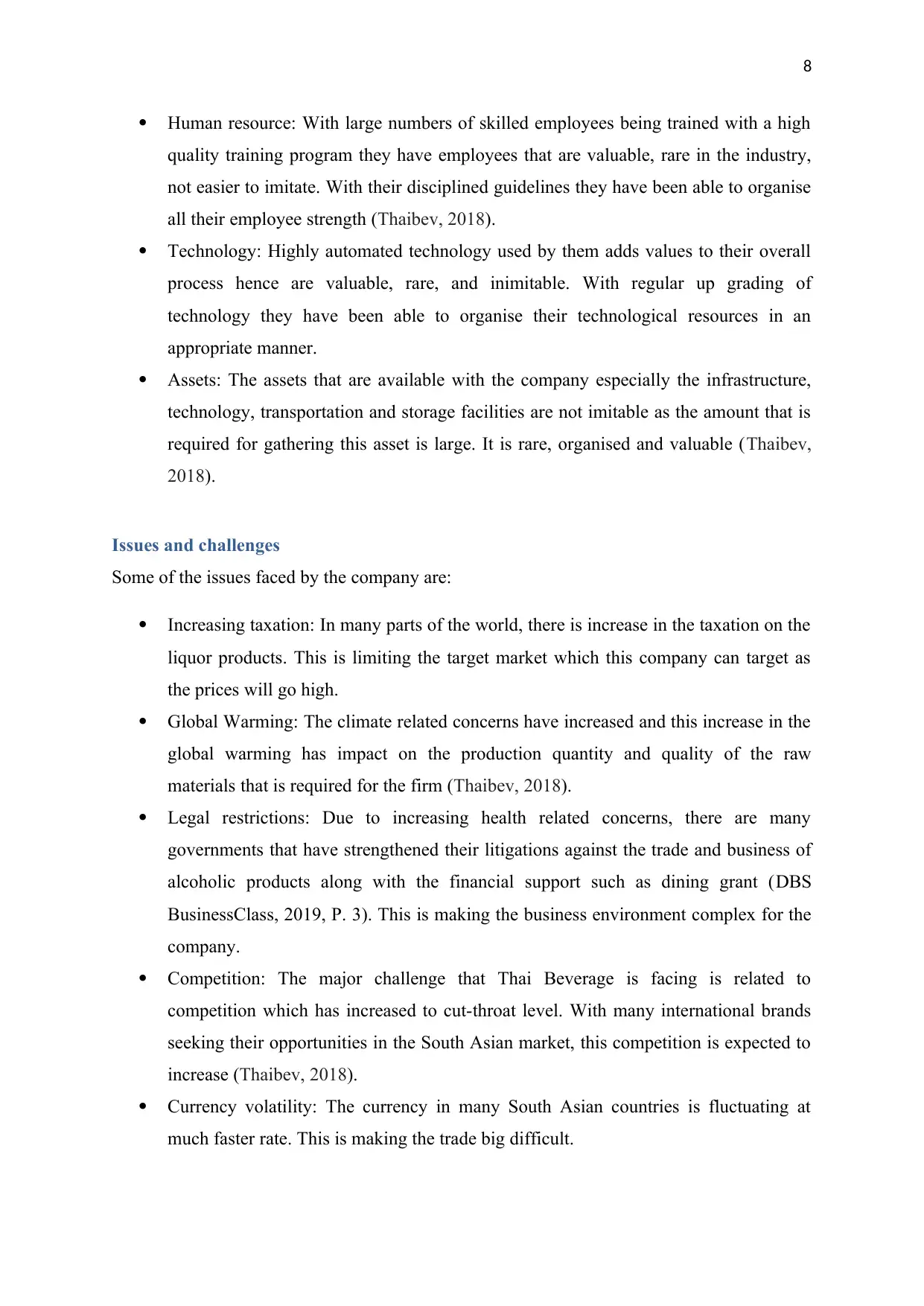
8
Human resource: With large numbers of skilled employees being trained with a high
quality training program they have employees that are valuable, rare in the industry,
not easier to imitate. With their disciplined guidelines they have been able to organise
all their employee strength (Thaibev, 2018).
Technology: Highly automated technology used by them adds values to their overall
process hence are valuable, rare, and inimitable. With regular up grading of
technology they have been able to organise their technological resources in an
appropriate manner.
Assets: The assets that are available with the company especially the infrastructure,
technology, transportation and storage facilities are not imitable as the amount that is
required for gathering this asset is large. It is rare, organised and valuable (Thaibev,
2018).
Issues and challenges
Some of the issues faced by the company are:
Increasing taxation: In many parts of the world, there is increase in the taxation on the
liquor products. This is limiting the target market which this company can target as
the prices will go high.
Global Warming: The climate related concerns have increased and this increase in the
global warming has impact on the production quantity and quality of the raw
materials that is required for the firm (Thaibev, 2018).
Legal restrictions: Due to increasing health related concerns, there are many
governments that have strengthened their litigations against the trade and business of
alcoholic products along with the financial support such as dining grant (DBS
BusinessClass, 2019, P. 3). This is making the business environment complex for the
company.
Competition: The major challenge that Thai Beverage is facing is related to
competition which has increased to cut-throat level. With many international brands
seeking their opportunities in the South Asian market, this competition is expected to
increase (Thaibev, 2018).
Currency volatility: The currency in many South Asian countries is fluctuating at
much faster rate. This is making the trade big difficult.
Human resource: With large numbers of skilled employees being trained with a high
quality training program they have employees that are valuable, rare in the industry,
not easier to imitate. With their disciplined guidelines they have been able to organise
all their employee strength (Thaibev, 2018).
Technology: Highly automated technology used by them adds values to their overall
process hence are valuable, rare, and inimitable. With regular up grading of
technology they have been able to organise their technological resources in an
appropriate manner.
Assets: The assets that are available with the company especially the infrastructure,
technology, transportation and storage facilities are not imitable as the amount that is
required for gathering this asset is large. It is rare, organised and valuable (Thaibev,
2018).
Issues and challenges
Some of the issues faced by the company are:
Increasing taxation: In many parts of the world, there is increase in the taxation on the
liquor products. This is limiting the target market which this company can target as
the prices will go high.
Global Warming: The climate related concerns have increased and this increase in the
global warming has impact on the production quantity and quality of the raw
materials that is required for the firm (Thaibev, 2018).
Legal restrictions: Due to increasing health related concerns, there are many
governments that have strengthened their litigations against the trade and business of
alcoholic products along with the financial support such as dining grant (DBS
BusinessClass, 2019, P. 3). This is making the business environment complex for the
company.
Competition: The major challenge that Thai Beverage is facing is related to
competition which has increased to cut-throat level. With many international brands
seeking their opportunities in the South Asian market, this competition is expected to
increase (Thaibev, 2018).
Currency volatility: The currency in many South Asian countries is fluctuating at
much faster rate. This is making the trade big difficult.
⊘ This is a preview!⊘
Do you want full access?
Subscribe today to unlock all pages.

Trusted by 1+ million students worldwide

9
Conclusion and Recommendation
From the above based report, it can be concluded that external environment of the company is
good and it might support the expansion policy of the company. The strategies that are used
by this company are growth strategy, diversity strategy, reach and branding strategy. The
internal environment needs to be more managed so as to remain successful. The resources of
this company have given them competitive advantage over the rivals. Human resource,
technology and assets plays give them competitive advantage over the rivals. Along with this,
the company faces issues such as competition, currency volatility, legal restrictions, global
warming and increased taxation.
On the basis of the report it can be recommended that this company needs to look for the
markets in India and China. This is because the demand for the premium alcoholic beverages
has been quite significant in these two countries. It is also recommended that this firm
chooses more of a digital medium for their marketing. In the non-alcoholic section, they need
to add more numbers of cultural drinks that is famous in different parts of South East Asia. It
is also critical to include customer feedback options within the marketing in which this
company has been little poor.
Conclusion and Recommendation
From the above based report, it can be concluded that external environment of the company is
good and it might support the expansion policy of the company. The strategies that are used
by this company are growth strategy, diversity strategy, reach and branding strategy. The
internal environment needs to be more managed so as to remain successful. The resources of
this company have given them competitive advantage over the rivals. Human resource,
technology and assets plays give them competitive advantage over the rivals. Along with this,
the company faces issues such as competition, currency volatility, legal restrictions, global
warming and increased taxation.
On the basis of the report it can be recommended that this company needs to look for the
markets in India and China. This is because the demand for the premium alcoholic beverages
has been quite significant in these two countries. It is also recommended that this firm
chooses more of a digital medium for their marketing. In the non-alcoholic section, they need
to add more numbers of cultural drinks that is famous in different parts of South East Asia. It
is also critical to include customer feedback options within the marketing in which this
company has been little poor.
Paraphrase This Document
Need a fresh take? Get an instant paraphrase of this document with our AI Paraphraser
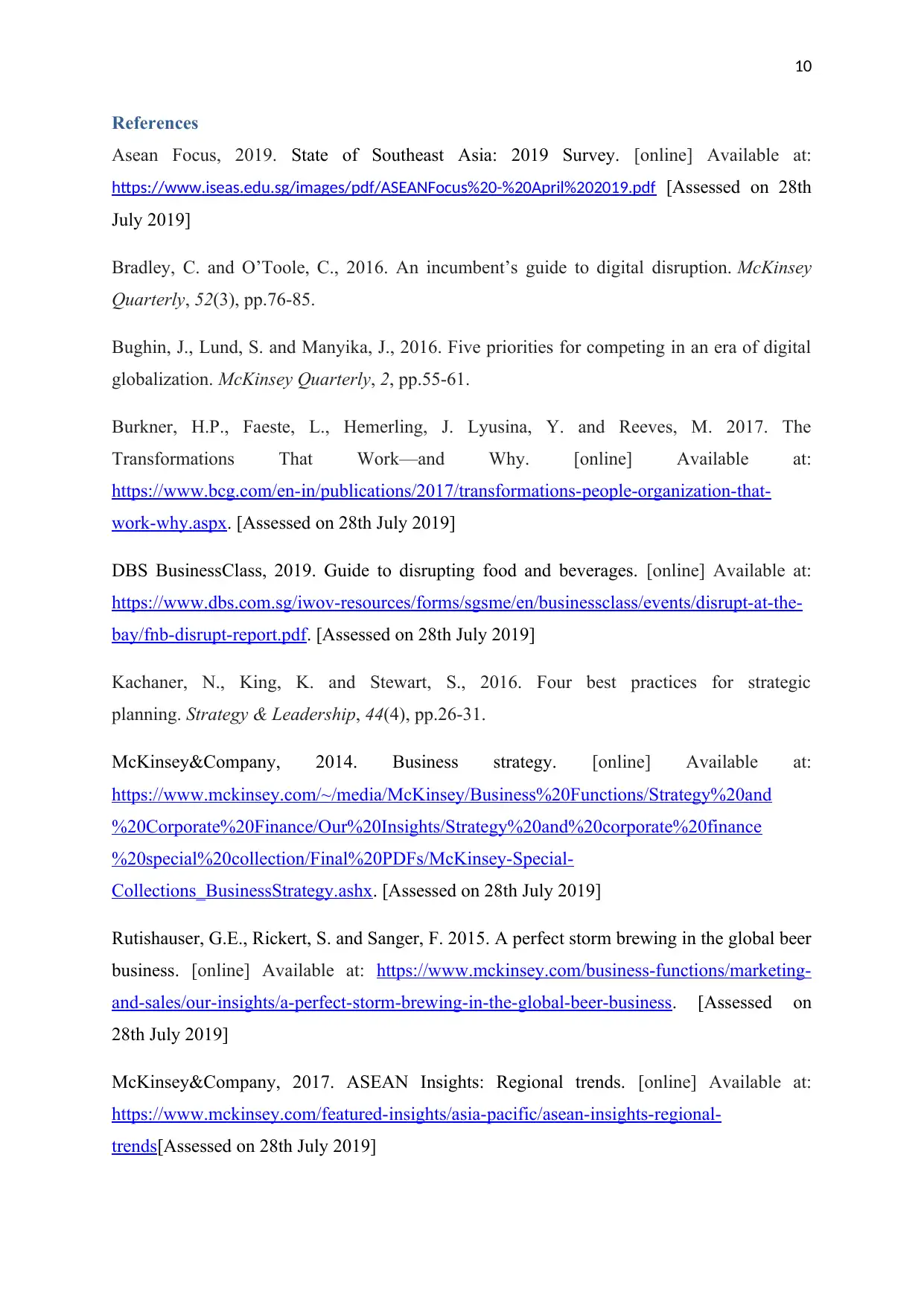
10
References
Asean Focus, 2019. State of Southeast Asia: 2019 Survey. [online] Available at:
https://www.iseas.edu.sg/images/pdf/ASEANFocus%20-%20April%202019.pdf [Assessed on 28th
July 2019]
Bradley, C. and O’Toole, C., 2016. An incumbent’s guide to digital disruption. McKinsey
Quarterly, 52(3), pp.76-85.
Bughin, J., Lund, S. and Manyika, J., 2016. Five priorities for competing in an era of digital
globalization. McKinsey Quarterly, 2, pp.55-61.
Burkner, H.P., Faeste, L., Hemerling, J. Lyusina, Y. and Reeves, M. 2017. The
Transformations That Work—and Why. [online] Available at:
https://www.bcg.com/en-in/publications/2017/transformations-people-organization-that-
work-why.aspx. [Assessed on 28th July 2019]
DBS BusinessClass, 2019. Guide to disrupting food and beverages. [online] Available at:
https://www.dbs.com.sg/iwov-resources/forms/sgsme/en/businessclass/events/disrupt-at-the-
bay/fnb-disrupt-report.pdf. [Assessed on 28th July 2019]
Kachaner, N., King, K. and Stewart, S., 2016. Four best practices for strategic
planning. Strategy & Leadership, 44(4), pp.26-31.
McKinsey&Company, 2014. Business strategy. [online] Available at:
https://www.mckinsey.com/~/media/McKinsey/Business%20Functions/Strategy%20and
%20Corporate%20Finance/Our%20Insights/Strategy%20and%20corporate%20finance
%20special%20collection/Final%20PDFs/McKinsey-Special-
Collections_BusinessStrategy.ashx. [Assessed on 28th July 2019]
Rutishauser, G.E., Rickert, S. and Sanger, F. 2015. A perfect storm brewing in the global beer
business. [online] Available at: https://www.mckinsey.com/business-functions/marketing-
and-sales/our-insights/a-perfect-storm-brewing-in-the-global-beer-business. [Assessed on
28th July 2019]
McKinsey&Company, 2017. ASEAN Insights: Regional trends. [online] Available at:
https://www.mckinsey.com/featured-insights/asia-pacific/asean-insights-regional-
trends[Assessed on 28th July 2019]
References
Asean Focus, 2019. State of Southeast Asia: 2019 Survey. [online] Available at:
https://www.iseas.edu.sg/images/pdf/ASEANFocus%20-%20April%202019.pdf [Assessed on 28th
July 2019]
Bradley, C. and O’Toole, C., 2016. An incumbent’s guide to digital disruption. McKinsey
Quarterly, 52(3), pp.76-85.
Bughin, J., Lund, S. and Manyika, J., 2016. Five priorities for competing in an era of digital
globalization. McKinsey Quarterly, 2, pp.55-61.
Burkner, H.P., Faeste, L., Hemerling, J. Lyusina, Y. and Reeves, M. 2017. The
Transformations That Work—and Why. [online] Available at:
https://www.bcg.com/en-in/publications/2017/transformations-people-organization-that-
work-why.aspx. [Assessed on 28th July 2019]
DBS BusinessClass, 2019. Guide to disrupting food and beverages. [online] Available at:
https://www.dbs.com.sg/iwov-resources/forms/sgsme/en/businessclass/events/disrupt-at-the-
bay/fnb-disrupt-report.pdf. [Assessed on 28th July 2019]
Kachaner, N., King, K. and Stewart, S., 2016. Four best practices for strategic
planning. Strategy & Leadership, 44(4), pp.26-31.
McKinsey&Company, 2014. Business strategy. [online] Available at:
https://www.mckinsey.com/~/media/McKinsey/Business%20Functions/Strategy%20and
%20Corporate%20Finance/Our%20Insights/Strategy%20and%20corporate%20finance
%20special%20collection/Final%20PDFs/McKinsey-Special-
Collections_BusinessStrategy.ashx. [Assessed on 28th July 2019]
Rutishauser, G.E., Rickert, S. and Sanger, F. 2015. A perfect storm brewing in the global beer
business. [online] Available at: https://www.mckinsey.com/business-functions/marketing-
and-sales/our-insights/a-perfect-storm-brewing-in-the-global-beer-business. [Assessed on
28th July 2019]
McKinsey&Company, 2017. ASEAN Insights: Regional trends. [online] Available at:
https://www.mckinsey.com/featured-insights/asia-pacific/asean-insights-regional-
trends[Assessed on 28th July 2019]
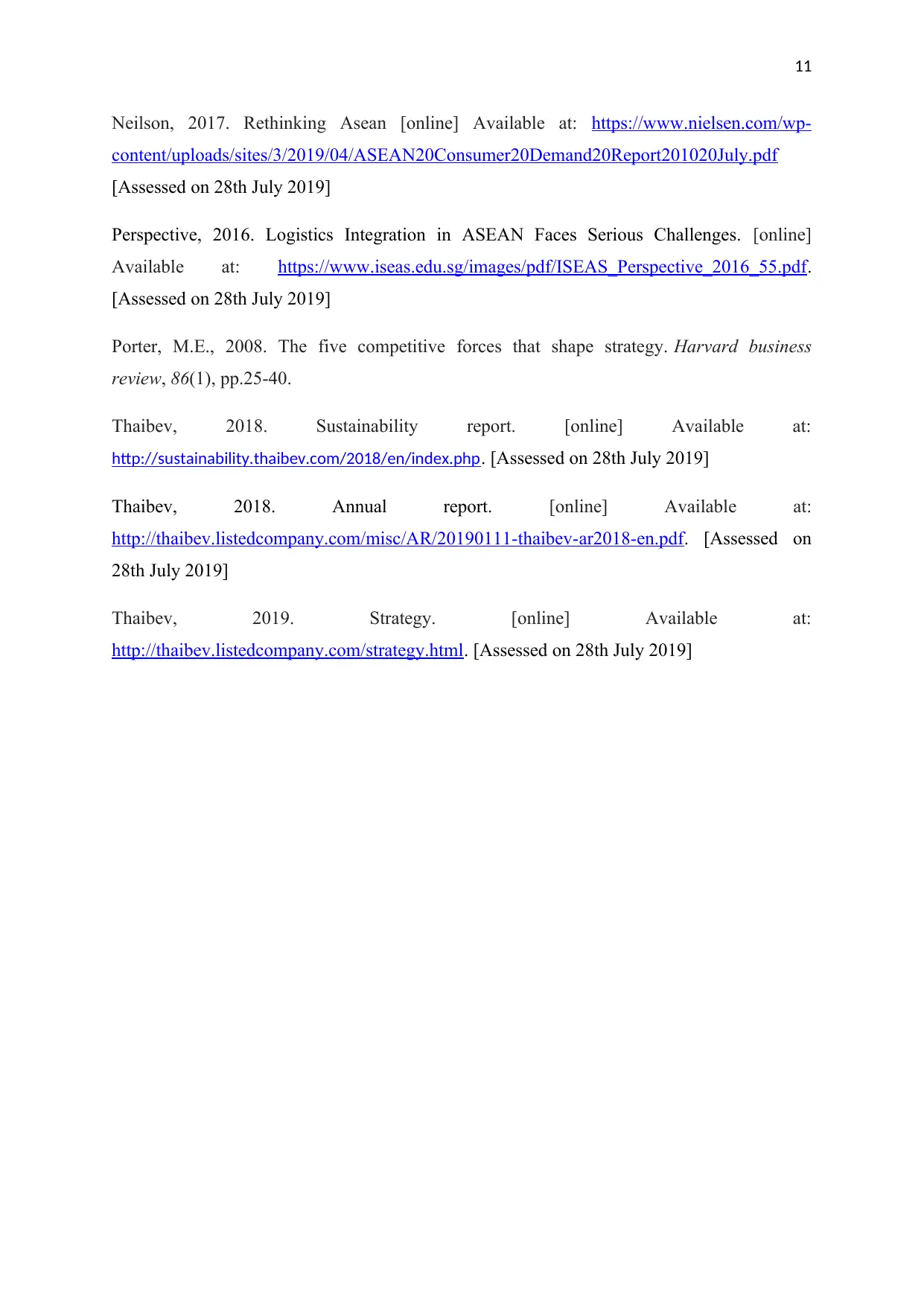
11
Neilson, 2017. Rethinking Asean [online] Available at: https://www.nielsen.com/wp-
content/uploads/sites/3/2019/04/ASEAN20Consumer20Demand20Report201020July.pdf
[Assessed on 28th July 2019]
Perspective, 2016. Logistics Integration in ASEAN Faces Serious Challenges. [online]
Available at: https://www.iseas.edu.sg/images/pdf/ISEAS_Perspective_2016_55.pdf.
[Assessed on 28th July 2019]
Porter, M.E., 2008. The five competitive forces that shape strategy. Harvard business
review, 86(1), pp.25-40.
Thaibev, 2018. Sustainability report. [online] Available at:
http://sustainability.thaibev.com/2018/en/index.php. [Assessed on 28th July 2019]
Thaibev, 2018. Annual report. [online] Available at:
http://thaibev.listedcompany.com/misc/AR/20190111-thaibev-ar2018-en.pdf. [Assessed on
28th July 2019]
Thaibev, 2019. Strategy. [online] Available at:
http://thaibev.listedcompany.com/strategy.html. [Assessed on 28th July 2019]
Neilson, 2017. Rethinking Asean [online] Available at: https://www.nielsen.com/wp-
content/uploads/sites/3/2019/04/ASEAN20Consumer20Demand20Report201020July.pdf
[Assessed on 28th July 2019]
Perspective, 2016. Logistics Integration in ASEAN Faces Serious Challenges. [online]
Available at: https://www.iseas.edu.sg/images/pdf/ISEAS_Perspective_2016_55.pdf.
[Assessed on 28th July 2019]
Porter, M.E., 2008. The five competitive forces that shape strategy. Harvard business
review, 86(1), pp.25-40.
Thaibev, 2018. Sustainability report. [online] Available at:
http://sustainability.thaibev.com/2018/en/index.php. [Assessed on 28th July 2019]
Thaibev, 2018. Annual report. [online] Available at:
http://thaibev.listedcompany.com/misc/AR/20190111-thaibev-ar2018-en.pdf. [Assessed on
28th July 2019]
Thaibev, 2019. Strategy. [online] Available at:
http://thaibev.listedcompany.com/strategy.html. [Assessed on 28th July 2019]
⊘ This is a preview!⊘
Do you want full access?
Subscribe today to unlock all pages.

Trusted by 1+ million students worldwide
1 out of 12
Related Documents
Your All-in-One AI-Powered Toolkit for Academic Success.
+13062052269
info@desklib.com
Available 24*7 on WhatsApp / Email
![[object Object]](/_next/static/media/star-bottom.7253800d.svg)
Unlock your academic potential
Copyright © 2020–2025 A2Z Services. All Rights Reserved. Developed and managed by ZUCOL.





